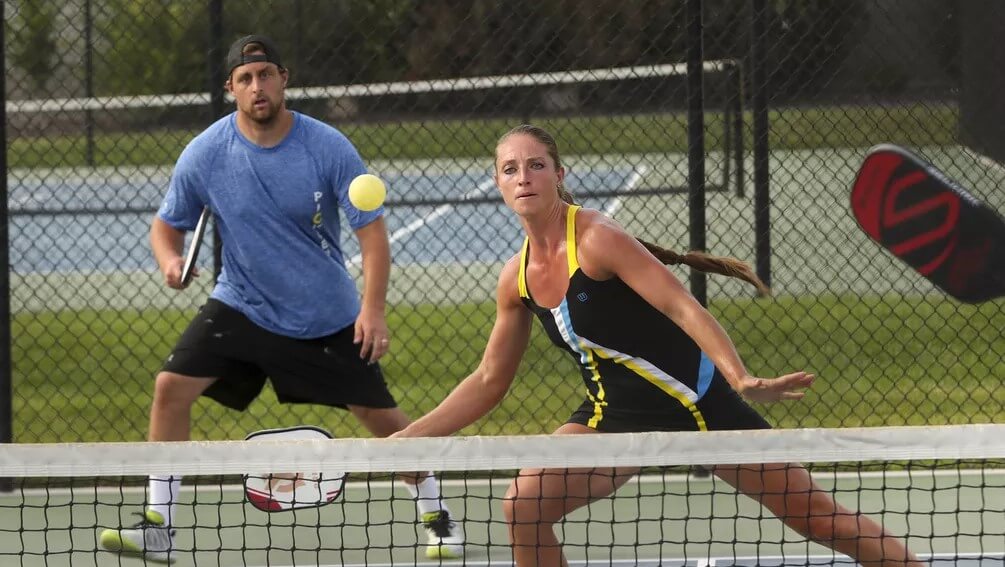There is a sport that has consistently been making waves and gaining popularity: pickleball. Some may compare it to tennis, some to ping pong, others may think that it is a combination of both. For those who are interested about this sport or contemplating about learning it, then the following should help you in learning more about the sport.
Similar to other racket sports, in pickleball, which can be in singles or doubles, the ball is hit back and forth over the net. Notably, this sport bears some similarity to tennis and ping pong. A pickleball court has the same size as a badminton court although the net is notably situated from the ground up to above the waist level.
Just like other similar sports, the goal in pickleball is to hit the ball over the net, toward the opponent’s court, with the ultimate aim of gaining a point or causing the opponent to miss or make an error. This sport attracts a large following given the wide variety of people that can play it. Whether they are pro, intermediate, or at the beginner level, pickleball players find the sport very rewarding.
Playing pickleball requires a certain equipment: the paddle. A pickleball paddle comes with a solid face and can vary in shape or size. Meanwhile, the pickleball is very recognizable for its holes. The ball is made from a lightweight plastic material.
Pickleball is played in accordance with certain rules. Of course, the most notable is hitting the ball back and forth over the net. However, when a player hits a ball, and the ball goes directly to the net or outside the court, then the opposing team gains the chance to serve or possibly wins the point. In addition, the ball is allowed to bounce off the ground only once. However, a player can also hit the ball before it lands on the ground, in a shot called the volley.
Specifically, the volley shot can be applied when the ball is directed to a player’s body. It is also a good strategy to shorten the reaction time of the opponents.
Now, a pickleball game always starts with a serve. Here, the ball is hit with an underhand shot. It should go over the net and reach the opponents’ court in a diagonal direction. In addition, the ball must pass over the non-volley zone line toward the opponents’ court. Before, the ball is not allowed to bounce during serves, but new rules have just been recently introduced regarding serve shots.
On the other hand, the player receiving the serve should allow the ball to bounce once before returning it. As this first return is completed, the serving team will also let the ball bounce once (two-bounce rule: one for the server, one for the returner) before exchanging shots with their opponents. The exchange of shots continues until one team commits an error or makes a point.

An important part of the court is the distance between the net and the non-volley zone line, that is, the kitchen or non-volley zone. Pickleball players cannot hit the a volley when their foot are inside the kitchen. In most games, pickleball players position themselves just behind the non-volley zone line. However, the opponents can push them back by hitting the ball further away or prevent them from going to the non-volley zone line after serving. Notably, players can enter and hit from the non-volley zone as long as they allow the ball to bounce once first.
Lastly, it is important to keep tabs of scores in pickleball. The target points should be 11, and a team must win by 2 points. When a team hits more than their opponents, that is, when their opponents miss hitting the ball back, then the former wins the exchange. But does this mean that they get a point? Not really. A team will only get a score if they SERVE the ball AND then win the rally.
Although winning a rally does not give a team a score, it will give a team to force their opponents to make the second serve. After the second serve, the other team now gets the chance to serve and thus also the opportunity to win a point.
Notably, scoring in pickle all is hard to understand at first. However, pickleball players can only increase their comprehension if they consistently play the game and attempt to apply their knowledge when they are actually inside the court. Of course, this should come hand in hand with the different knowledge and skills in pickleball.
To sum up, pickleball is a great sport that can be played by anyone, regardless of their playing level. Although learning about the game and its rules can be a “pickle,” once mastered, a player will finally get the chance to have some fun engaging in the game. Hopefully, overtime, they can reap the notable benefits of this sport.
